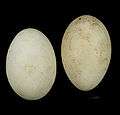Grey crowned crane
| Gray crowned crane | |
|---|---|
 | |
| Scientific classification | |
| Kingdom: | Animalia |
| Phylum: | Chordata |
| Class: | Aves |
| Order: | Gruiformes |
| Family: | Gruidae |
| Genus: | Balearica |
| Species: | B. regulorum |
| Binomial name | |
| Balearica regulorum Bennett, 1834 | |
The grey crowned crane (Balearica regulorum) is a bird in the crane family Gruidae. It occurs in dry savannah in Africa south of the Sahara, although it nests in somewhat wetter habitats. They can also be found in marshes, cultivated lands and grassy flatlands near rivers and lakes in Uganda and Kenya and as far south as South Africa. This animal does not migrate due to the perfect climate it inhabits. There are two subspecies. The East African B. r. gibbericeps (crested crane) occurs in the east of the Democratic Republic of the Congo and in Uganda, of which it is the national bird represented in its national flag, and Kenya to eastern South Africa. It has a larger area of bare red facial skin above the white patch than the smaller nominate species, B. r. regulorum (South African crowned crane), which breeds from Angola south to South Africa. This species and the closely related black-crowned crane are the only cranes that can roost in trees, because of a long hind toe that can grasp branches. This habit, amongst other things, is a reason why the relatively small Balearica cranes are believed to closely resemble the ancestral members of the Gruidae.
Behaviour
The grey crowned crane has a breeding display involving dancing, bowing, and jumping. It has a booming call which involves inflation of the red gular sac. It also makes a honking sound quite different from the trumpeting of other crane species. Both sexes dance, and immature birds join the adults. Dancing is an integral part of courtship, but also may be done at any time of the year.
Flocks of 30-150 birds are not uncommon.
Reproduction
During the breeding season, pairs of cranes construct a large nest; a platform of grass and other plants in tall wetland vegetation. The grey crowned crane lays a clutch of 2-5 glossy, dirty-white eggs, which are incubated by both sexes for 28–31 days. Chicks are precocial, can run as soon as they hatch, and fledge in 56–100 days.
Description
The grey crowned crane is about 1 m (3.3 ft) tall and weighs 3.5 kg (7.7 lbs) and a wingspan of 2 m (6.5 ft). Its body plumage is mainly grey. The wings are also predominantly white, but contain feathers with a range of colours. The head has a crown of stiff golden feathers. The sides of the face are white, and there is a bright red inflatable throat pouch. The bill is relatively short and grey, and the legs are black. They have long legs for wading through the grasses. The feet are large, yet slender, adapted for balance rather than defence or grasping. The sexes are similar, although males tend to be slightly larger. Young birds are greyer than adults, with a feathered buff face.
Diet
These cranes are omnivores, eating plants, seeds, grain, insects, frogs, worms, snakes, small fish and the eggs of aquatic animals. Stamping their feet as they walk, they flush out insects which are quickly caught and eaten. The birds also associate with grazing herbivores, benefiting from the ability to grab prey items disturbed by antelopes and gazelles. They spend their entire day looking for food. At night, the crowned crane spends its time in the trees sleeping and resting.
Range
The grey crowned crane is the national bird of Uganda and features in the country's flag and coat of arms. Although the grey crowned crane remains common over much of its range, it faces threats to its habitat due to drainage, overgrazing, and pesticide pollution. Their global population is estimated to be between 58,000 and 77,000 individuals. In 2012 it was uplisted from vulnerable to endangered by the IUCN.[2]
Gallery
 Portrait
Portrait Grey crowned crane in captivity, kolkata zoo
Grey crowned crane in captivity, kolkata zoo.jpg) Grey crowned cranes at The Bronx Zoo in New York City
Grey crowned cranes at The Bronx Zoo in New York City.jpg) In Serengeti National Park, Tanzania
In Serengeti National Park, Tanzania In Tanzania
In Tanzania
 South-African crowned crane
South-African crowned crane Eggs of Balearica regulorum gibbericeps MHNT
Eggs of Balearica regulorum gibbericeps MHNT.jpg)
- In captivity at Martin Mere
.jpg) A Chick in Tehran Birds Garden
A Chick in Tehran Birds Garden.jpg) In South Luangwa National Park, Zambia
In South Luangwa National Park, Zambia
References
- ↑ BirdLife International (2013). "Balearica regulorum". IUCN Red List of Threatened Species. Version 2013.2. International Union for Conservation of Nature. Retrieved 26 November 2013.
- ↑ "Recently recategorised species". Birdlife International (2012). Retrieved 15 June 2012.
External links
| Wikimedia Commons has media related to Balearica regulorum. |
| Wikispecies has information related to: Balearica regulorum |
- Species text in The Atlas of Southern African Birds
- Grey crowned crane (International Crane Foundation)
- East African crowned crane
- Grey crowned crested crane (suburb2suburb.com)
